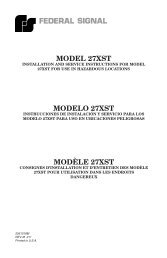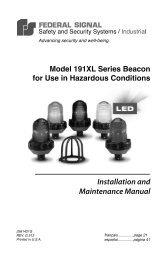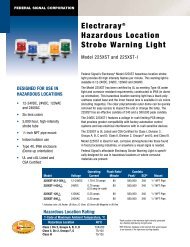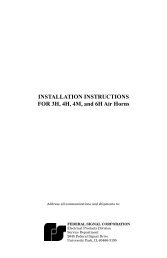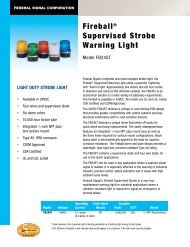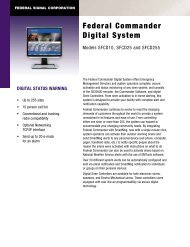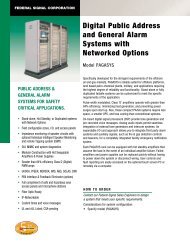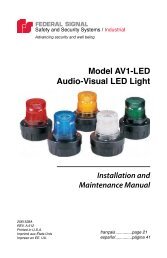UltraVoice Manual - Alerting & Notification
UltraVoice Manual - Alerting & Notification
UltraVoice Manual - Alerting & Notification
Create successful ePaper yourself
Turn your PDF publications into a flip-book with our unique Google optimized e-Paper software.
7.2 General Maintenance<br />
A. Driver Replacement/Inspection<br />
Each amplifier drives four 100-Watt<br />
speakers.<br />
To measure the resistance of a given<br />
speaker set, proceed as follows:<br />
1. Set an ohmmeter to its low<br />
resistance range, and hold the<br />
ohmmeter probes to the outputs<br />
on the terminal strip (JP21-28)<br />
(at the bottom of the system<br />
mother board).<br />
2. Observe the DC resistance of the<br />
speakers. Normal DC resistance<br />
of a speaker set of 4 drivers is<br />
approximately 4.5 ohms. A DC<br />
resistance measurement of less<br />
than 3.5 ohms indicates that one<br />
or both of the speakers is<br />
probably shorted. A reading of<br />
approximately 9 ohms or more<br />
indicates that at least one of the<br />
speakers in the set is open; a<br />
reading of infinity indicates that<br />
both speaker sets are open.<br />
3. If a resistance is abnormal,<br />
perform resistance checks on<br />
each speaker individually at the<br />
speaker array. Refer to the signal<br />
connections section for speaker<br />
locations. Each individual driver<br />
is 4.5 ohms.<br />
4. To replace a defective driver,<br />
remove the four (4) hex head 1/4inch<br />
mounting bolts that are<br />
holding the inspection plate.<br />
Make sure the flat washers and<br />
split washers are not misplaced.<br />
Federal Signal <strong>UltraVoice</strong><br />
Installation and Operation <strong>Manual</strong><br />
MAINTENANCE<br />
60<br />
Note the color and location of the<br />
wires going to the driver.<br />
Remove the driver by turning it<br />
counterclockwise. Make sure that<br />
the male threads are lightly<br />
greased, then install the new<br />
driver. Reconnect the wires as<br />
previously noted. Reinstall the<br />
inspection plate. Repeat<br />
resistance check above.<br />
5. Test the siren to verify the driver<br />
has been properly installed.<br />
B. Signal Operational Check<br />
1. When checking for proper control<br />
module output, unplug the<br />
terminal strip connectors to the<br />
speakers (at the bottom of the<br />
system motherboard) to eliminate<br />
output from the speaker array.<br />
2. Activate each of the signals and<br />
observe the signal indicators on<br />
the control module and the<br />
amplifiers.<br />
3. If desired, an oscilloscope or<br />
digital multi-meter (DMM) can be<br />
connected to the amplifier<br />
module output terminal strip to<br />
observe the amplifier output. This<br />
output should be at least 67 VRMS<br />
during a signal. To limit sound<br />
output, plug in one amplifier<br />
terminal strip connector at a time<br />
during this test.<br />
4. Plug all of the amplifier terminal<br />
strip connectors to enable<br />
amplifier outputs.



